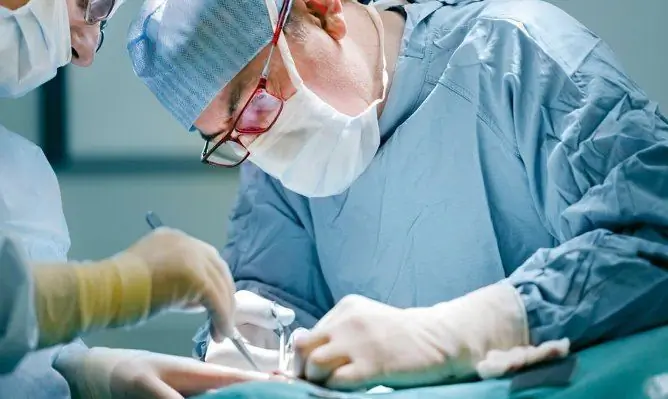- Author Rachel Wainwright [email protected].
- Public 2023-12-15 07:39.
- Last modified 2025-11-02 20:14.
Inguinal hernia in women
The content of the article:
- Causes and risk factors
- Forms of the disease
- Symptoms of an inguinal hernia in women
- Diagnostics
- Inguinal hernia treatment in women
- Types of surgery for inguinal hernia in women
- Potential consequences and complications
- Physiotherapy for inguinal hernia in women
- Forecast
- Prevention
An inguinal hernia in women is a pathological protrusion of some internal organs beyond the anterior abdominal wall through the inguinal canal.
Inguinal hernias in women are almost always acquired. They are both unilateral and bilateral. The hernial sac can include loops of the large or small intestine, omentum, ovary, bladder, fallopian tubes.

An inguinal hernia is the exit of internal organs through the inguinal canal to the outside
The inguinal canal is a paired anatomical formation, which is a slit from 4 to 6 cm long, which are located in the lower part of the inguinal region on the left and right. Through this formation in women passes the round ligament of the uterus, and in men the spermatic cord. The walls of the inguinal canal are formed by the aponeurosis of the external oblique muscle of the abdomen, the transverse fascia, the fibers of the transverse and internal oblique muscles of the abdomen, the groove of the inguinal ligament. In women, the diameter of the inguinal canal is smaller than in men. In addition, the aponeurosis of the external oblique muscle of the abdomen is stronger, and the fibers of the connective tissue that limit the outer ring of the inguinal canal are intertwined more tightly than in men. That is why in women, inguinal hernias are rare.
Causes and risk factors
The main reasons for the formation of inguinal hernias in women are conditions that lead to an increase in intra-abdominal pressure, in the presence of weakness of the muscles that form the outer ring of the inguinal canal. These conditions include:
- significant physical activity (lifting weights, weightlifting, doing abdominal exercises);
- chronic constipation;
- repeated pregnancy;
- difficult labor (large fetus, breech presentation);
- overweight;
- diseases of the bronchopulmonary system, accompanied by chronic cough.
Factors that increase the risk of developing an inguinal hernia in women include:
- a sharp change in body weight;
- congenital muscle weakness;
- hypodynamia;
- frequent screaming and crying in childhood;
- hereditary predisposition.
Forms of the disease
Inguinal hernias in women are only straight, which is explained by the absence of the spermatic cord in the female inguinal canal.
A hernial protrusion can be reducible (in the supine position, its size decreases or it completely disappears) and irreducible.
When the hernial sac is squeezed in the area of the hernial gate, a restrained inguinal hernia develops in women.
Sliding inguinal hernias are especially dangerous. They are formed by the visceral and parietal sheets of the peritoneum and are prone to frequent infringement.
Symptoms of an inguinal hernia in women
The main symptom of an inguinal hernia in women is the appearance of a characteristic tumor-like protrusion in the groin area. Its size can be different and does not affect the risk of infringement in any way. Small hernias, usually in the supine position and in a relaxed state, spontaneously reset, and when straining they appear again.

The main symptom of an inguinal hernia in women is a tumor-like protrusion in the groin area
Signs of an inguinal hernia in women also depend on the stage of the disease. With a beginning hernia, the volumetric formation in the groin is not determined, there is no pain. The disease manifests itself only in the fact that some patients, under the influence of intense physical exertion in the groin area, have a feeling of heaviness, discomfort.
With a formed inguinal hernia in women, the symptoms become more pronounced. A tumor-like protrusion appears in the area of the inguinal fold or in the area of the labia majora. Pains appear, their intensity increases over time, they become permanent and do not disappear even after a long rest, which significantly reduces the ability to work. Hernial protrusions of considerable volume create pronounced discomfort when moving, performing normal daily work.
Other symptoms of inguinal hernia in women are largely determined by which organs fill the hernial sac. When exiting through the inguinal canal of the uterus, fallopian tube or ovary, women complain of pain in the lower abdomen, radiating to the sacrum or lower back. An increase in the intensity of pain during the days of menstrual bleeding is characteristic.
The exit into the hernial sac of the loop of the large intestine is clinically accompanied by flatulence, intestinal colic, and chronic constipation.
In a sliding inguinal hernia, the bladder wall and sometimes the ureter often enter the hernial sac. In this case, signs of an inguinal hernia in women are dysuric disorders (frequent, painful urination).
When an inguinal hernia is pinched, women experience symptoms of an acute abdomen:
- sharp pains in the lower abdomen;
- severe nausea, repeated vomiting;
- delay in the discharge of gases and feces;
- strong tension of the muscles of the anterior abdominal wall of a protective nature (board-shaped abdomen);
- positive symptom of Shchetkin - Blumberg, indicating irritation of the peritoneum.
Diagnostics
Diagnosis of an inguinal hernia in women is usually not difficult and is based on the characteristic clinical signs of the disease (the presence of a tumor-like formation in the groin area in combination with pain syndrome of a certain localization), as well as data from an instrumental examination, including:
- ultrasound examination of the abdominal cavity organs, small pelvis (bladder, uterus, ovaries);
- herniography - an X-ray method for examining a hernial sac with the introduction of a contrast agent into it by injection;
- irrigoscopy - X-ray examination of the large intestine after filling it with barium contrast;
- cystoscopy is an endoscopic technique that allows you to examine the inner surface of the bladder.

Ultrasound of the abdominal cavity and other instrumental studies can diagnose an inguinal hernia in women
Inguinal hernia treatment in women
The only method of treating an inguinal hernia in women is to remove it surgically. It is advisable to perform the operation in a planned manner, before the development of infringement and complications. Conservative tactics is possible only if there are contraindications to planned intervention (pregnancy, old age, the presence of severe concomitant diseases). In this case, patients are recommended:
- limit the level of physical activity;
- wear a bandage systematically.
The bandage is selected individually by the surgeon. It should be worn in the morning, without getting out of bed, making sure that the sealing tabs are located exactly over the hernial protrusion. The bandage should be washed regularly using a neutral detergent. Wearing a bandage does not allow to cure the disease, its purpose is to stop the progression of the hernia, to reduce the risk of infringement. If, nevertheless, an infringement of an inguinal hernia occurs in women, then the only method of treatment is surgical intervention, which is performed according to vital (vital) indications.
Types of surgery for inguinal hernia in women
Currently, the following surgical techniques are used to remove an inguinal hernia in women:
- Stretch (classical) hernioplasty. The closure of the hernial orifice is carried out by tightening the areas of muscles, fascia. This technique is currently used extremely rarely and only with minor hernial protrusions, since relapses are frequent after it. In addition, in the area of strained tissues, circulatory disorders of one degree or another may be observed.
- Laparoscopic hernioplasty. The intervention is performed using modern endoscopic equipment through a small incision (no more than 1 cm) in the abdominal cavity. The main advantages of this operation for inguinal hernia in women are low trauma to soft tissues, low blood loss, low risk of complications and a short rehabilitation period.
- Tension-free hernioplasty. This technique involves closing the hernia orifice with a special mesh prosthesis. Through its cells, fibers of connective tissue grow in the future and reliably close the lumen of the inguinal canal. The main advantage of this operation is the low recurrence rate. However, there is also a drawback - the mesh prosthesis is a material foreign to the body and in a small number of patients it is rejected.
Attention! Photo of shocking content.
Click on the link to view.
In the postoperative period, in order to prevent the addition of infectious and inflammatory complications, antibiotic therapy is prescribed. Its duration is determined by the surgeon based on the characteristics of the disease, the patient's condition and the type of surgery.
Laparoscopic surgery for inguinal hernia in women is often performed on an outpatient basis, and the patient can leave the clinic on the same day. In other cases, the hospitalization period is 7-14 days.
In the postoperative period, exercise therapy and dietary nutrition are recommended, which includes easily digestible meals rich in vitamins and microelements.
Potential consequences and complications
Complications of an inguinal hernia in women can develop if it is infringed. These include:
- organ necrosis within the hernial sac (ovary, bowel loops, bladder wall);
- peritonitis;
- coprostasis;
- intestinal obstruction.
The chance of recurrence of an inguinal hernia in women is approximately 10%. Relapses most often occur after classical hernioplasty.
Physiotherapy for inguinal hernia in women
Some women believe that regular exercise will help them build abs and cure an inguinal hernia without surgery. In fact, this opinion is wrong. If the hernia has already formed, then you can get rid of it exclusively by surgery. In addition, intense physical activity threatens to infringement of an inguinal hernia and the development of potentially life-threatening complications.
Physiotherapy exercises can be effective only as a method of preventing the development of the disease (in the presence of a hereditary predisposition, but before the first symptoms of the disease appear), as well as its recurrence in the future. After hernia repair, you should start therapeutic exercises with the permission of the attending physician. The selection of exercises and control of their correct implementation is carried out by an exercise therapy instructor. After the patient has mastered the technique of each exercise, she can do it on her own at home.
Forecast
With the timely detection of an inguinal hernia and its removal, the prognosis is favorable. A woman's ability to work is fully restored in a short time.
With the infringement of the hernial contents and the addition of complications, the prognosis significantly worsens. It is most serious with the development of diffuse peritonitis, the mortality rate in this case, according to various authors, ranges from 5 to 20%.
Prevention
The main measures to prevent the formation of inguinal hernias in women are:
- maintaining normal body weight (body mass index in the range of 18.5-24.99);
- prevention of groin injuries;
- wearing during pregnancy and in the postpartum period a special bandage;
- when practicing women's weightlifting, the mandatory use of special protective bandages;
- timely and active treatment of respiratory diseases, which are accompanied by a cough;
- active treatment of chronic constipation.
YouTube video related to the article:

Elena Minkina Doctor anesthesiologist-resuscitator About the author
Education: graduated from the Tashkent State Medical Institute, specializing in general medicine in 1991. Repeatedly passed refresher courses.
Work experience: anesthesiologist-resuscitator of the city maternity complex, resuscitator of the hemodialysis department.
The information is generalized and provided for informational purposes only. At the first sign of illness, see your doctor. Self-medication is hazardous to health!






